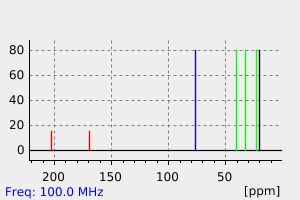2-acetoxycyclohexanone | 17472-04-7
中文名称
——
中文别名
——
英文名称
2-acetoxycyclohexanone
英文别名
2-oxocyclohexyl acetate;(2-oxocyclohexyl) acetate
CAS
17472-04-7
化学式
C8H12O3
mdl
MFCD00043478
分子量
156.181
InChiKey
DVPFXXZVXFSUTH-UHFFFAOYSA-N
BEILSTEIN
——
EINECS
——
-
物化性质
-
计算性质
-
ADMET
-
安全信息
-
SDS
-
制备方法与用途
-
上下游信息
-
文献信息
-
表征谱图
-
同类化合物
-
相关功能分类
-
相关结构分类
计算性质
-
辛醇/水分配系数(LogP):0.8
-
重原子数:11
-
可旋转键数:2
-
环数:1.0
-
sp3杂化的碳原子比例:0.75
-
拓扑面积:43.4
-
氢给体数:0
-
氢受体数:3
SDS
上下游信息
-
下游产品
中文名称 英文名称 CAS号 化学式 分子量 (+)-(2R)-2-乙酰氧基环己酮 (+)-(2R)-2-acetoxycyclohexanone 64363-90-2 C8H12O3 156.181 —— α-Butoxycyclohexanon 33371-99-2 C10H18O2 170.252
反应信息
-
作为反应物:描述:参考文献:名称:铊(iii)合成α-乙酰氧基和甲酰氧基酮促进α-氧化摘要:在 60 °C 的酰胺溶剂中用三氟甲磺酸铊 (III) 处理酮 30 分钟,然后加入少量 H2O,干净地提供相应的 α-酰氧基酮。DOI:10.1039/b102192n
-
作为产物:描述:参考文献:名称:DBU 介导的 β-二羰基氧化:空气气氛下羟基化和重排产物的形成摘要:在空气气氛下,在 1,8-二氮杂双环[5.4.0]undec-7-ene (DBU) 存在下,探索了乙腈中不同 β-二羰基的氧化。DBU的存在导致羟基化产物或源自羟基化产物的重排产物的形成。具体而言,当存在额外的1,2-双(二苯基膦基)乙烷和ROH时,2-氧代环戊烷甲酸酯向2-羟基己二酸酯的转化以良好的产率实现。事实证明,DBU 对于这一转变是不可或缺的,并且表现出了超出其通常作为基地作用的特殊性。DOI:10.1055/a-2232-8776
-
作为试剂:描述:参考文献:名称:The Condensation of 2-Hydroxy- and 2-Acetoxycyclohexanone with 1-Diethylamino-3-pentanone摘要:DOI:10.1021/ja01110a017
文献信息
-
[EN] NOVEL COMPOUNDS<br/>[FR] NOUVEAUX COMPOSÉS申请人:GLAXOSMITHKLINE IP DEV LTD公开号:WO2015180612A1公开(公告)日:2015-12-03Disclosed are novel retinoid-related orphan receptor gamma (RORγ) modulators and their use in the treatment of diseases mediated by RORγ.揭示了新型视黄醇相关孤儿受体γ(RORγ)调节剂及其在通过RORγ介导的疾病治疗中的应用。
-
Chemoselective Oxidation of Equatorial Alcohols with N-Ligated λ<sup>3</sup>-Iodanes作者:Myriam Mikhael、Sophia A. Adler、Sarah E. WengryniukDOI:10.1021/acs.orglett.9b02018日期:2019.8.2of nitrogen-ligated (bis)cationic λ3-iodanes (N-HVIs) for alcohol oxidation and their unprecedented levels of selectivity for the oxidation of equatorial over axial alcohols. The conditions are mild, and the simple pyridine-ligated reagent (Py-HVI) is readily synthesized from commercial PhI(OAc)2 and can be either isolated or generated in situ. Conformational selectivity is demonstrated in both flexible
-
Microwave-Enhanced Coupling of Carboxylic Acids with Liquid Ketones and Cyclic Ethers Using Tetrabutylammonium Iodide/<i>t</i>-Butyl Hydroperoxide作者:Pablo Macías-Benítez、F. Javier Moreno-Dorado、Francisco M. GuerraDOI:10.1021/acs.joc.0c00519日期:2020.5.1The oxidative coupling of carboxylic acids with liquid ketones and cyclic ethers has been accomplished in minutes using t-butyl hydroperoxide in the presence of tetrabutylammonium iodide under microwave irradiation in the absence of a solvent. In addition to drastically shortening the reaction times, the use of microwaves resulted, in general, in yields equal to or higher than those obtained by conventional
-
A Multicatalyst System for the One‐Pot Desymmetrization/Oxidation of <i>meso</i> ‐1,2‐Alkane Diols作者:Christian E. Müller、Radim Hrdina、Raffael C. Wende、Peter R. SchreinerDOI:10.1002/chem.201100498日期:2011.5.27Two is better than one: We demonstrate the viability of an organocatalytic reaction sequence along a short peptide backbone that carries two independent catalytic functionalities, which allow the rapid, one‐pot acylative desymmetrization and oxidation of meso‐alkane‐1,2‐diols to the corresponding acetylated acetoins with good yields and enantioselectivities (see scheme).
-
Chlorierungsreaktionen mit den systemen Pb-IV-acetat-(CH3)3SiCl und Pb-IV-acetat—CH3COCl作者:E. Zbiral、K. KischaDOI:10.1016/s0040-4020(01)82727-7日期:1969.1Multiple bonds react with the title systems to give 1,2-dichlorocompounds. 1-Acetoxy-2-chlorocompounds are formed as typical byproducts. The stereochemistry of the addition varies from mainly cis to exclusively trans. Simple ketones give α-monochlorketones in good yields.
表征谱图
-
氢谱1HNMR
-
质谱MS
-
碳谱13CNMR
-
红外IR
-
拉曼Raman
-
峰位数据
-
峰位匹配
-
表征信息
同类化合物
(反式)-4-壬烯醛
(s)-2,3-二羟基丙酸甲酯
([1-(甲氧基甲基)-1H-1,2,4-三唑-5-基](苯基)甲酮)
(Z)-4-辛烯醛
(S)-氨基甲酸酯β-D-O-葡糖醛酸
(S)-3-(((2,2-二氟-1-羟基-7-(甲基磺酰基)-2,3-二氢-1H-茚满-4-基)氧基)-5-氟苄腈
(R)-氨基甲酸酯β-D-O-葡糖醛酸
(5,5-二甲基-2-(哌啶-2-基)环己烷-1,3-二酮)
(2,5-二氟苯基)-4-哌啶基-甲酮
龙胆苦苷
龙胆二糖甲乙酮氰醇(P)
龙胆二糖丙酮氰醇(P)
龙胆三糖
龙涎酮
齐罗硅酮
齐留通beta-D-葡糖苷酸
鼠李糖
黑芥子苷单钾盐
黑海棉酸钠盐
黑木金合欢素
黑曲霉三糖
黑介子苷
黄尿酸8-O-葡糖苷
麻西那霉素II
麦迪霉素
麦芽糖脎
麦芽糖基海藻糖
麦芽糖1-磷酸酯
麦芽糖
麦芽四糖醇
麦芽四糖
麦芽十糖
麦芽六糖
麦芽五糖水合物
麦芽五糖
麦芽五糖
麦芽五糖
麦芽三糖醇
麦芽三糖
麦芽三糖
麦芽三塘水合
麦芽七糖水合物
麦芽七糖
麦法朵
麦可酚酸-酰基-Β-D-葡糖苷酸
麦利查咪
麝香酮
鹤草酚
鸢尾酚酮 3-C-beta-D-吡喃葡萄糖苷
鸡矢藤苷







